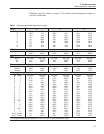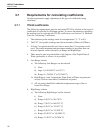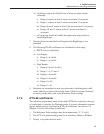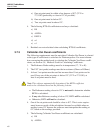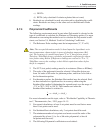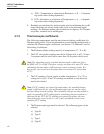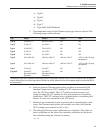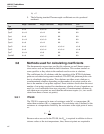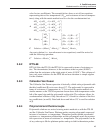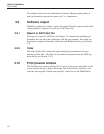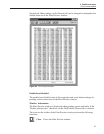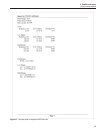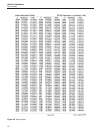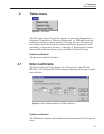
solve for two coefficients. The example below shows a set of four equations
representing data at five temperatures ( R
tpw
and resistance at four test tempera
-
tures) along with the matrix method used to solve the overdetermined set.
A
Δ
Δ
WaW bW
WaW bW
TT T
TT T
11 1
2
22 2
2
11
11
=−+−
=−+−
[( ) ( )]
[( ) ( )]
Δ
Δ
WaW bW
WaW bW
TT T
TT T
33 3
2
44 4
2
11
11
=−+−
=−+−
[( ) ( )]
[( ) ( )]
B
Matrix
W
W
W
W
Matrix
W
T
T
T
T
T
1
1
2
3
4
2
1
1
=
⎡
⎣
⎢
⎢
⎢
⎢
⎤
⎦
⎥
⎥
⎥
⎥
=
−
Δ
Δ
Δ
Δ
()()
()()
()()
()(
W
WW
WW
WW
T
TT
TT
TT
1
2
22
2
33
2
44
1
11
11
1
−
−−
−−
−−
⎡
⎣
⎢
⎢
⎢
⎢
⎢
⎤
⎦
⎥
⎥
⎥
⎥
⎥
1
2
)
C
Solution Matrix Matrix Matrix Matrix
TT
=⋅ ⋅⋅()
–
22
1
21
An exact solution (i.e., two unknowns in two equations) would be arrived at
with the following operation:
C′
Solution Matrix Matrix=⋅
2
1
1
–
3.8.2 IPTS-68
IPTS-68 Like the ITS-90, the IPTS-68 is expressed in terms of resistance ra-
tios. The denominator, however, is the resistance at the ice point (0.000C)
rather than the resistance at the triple point of water (0.010C). This software al-
lows only exact solutions for the IPTS-68 and uses iteration or simple algebra
for the solutions.
3.8.3 Callendar-Van Dusen
The Callendar-Van Dusen expression is basically a third order polynomial with
the third coefficient (β) set to zero above 0°C. The polynomial is expressed in
terms of resistance vs. temperature in °C. It is solved by matrix methods in a
similar manner as the ITS-90 expression shown above with temperature on the
left of the equal sign and the polynomial on the right. The software allows for
overdetermined solutions. Only data above 0°C is used for solution of the first
two coefficients (α and δ). Data both above and below 0°C is used for solution
of β.
3.8.4 Polynomial and thermocouple
Polynomial solutions are arrived at using matrix methods as with the ITS-90
and the Callendar-Van Dusen. Platinum probes require polynomials expressed
in terms of resistance vs. temperature. Thermistor probes exhibit exponential
resistance vs. temperature relationships and the polynomials used are exponen
-
tial expressions in terms of resistance vs. temperature. The polynomials can be
of any order up to 9th for platinum probes and up to 6th for thermistor probes.
45
3 Coefficients menu
Methods used for calculating coefficients



